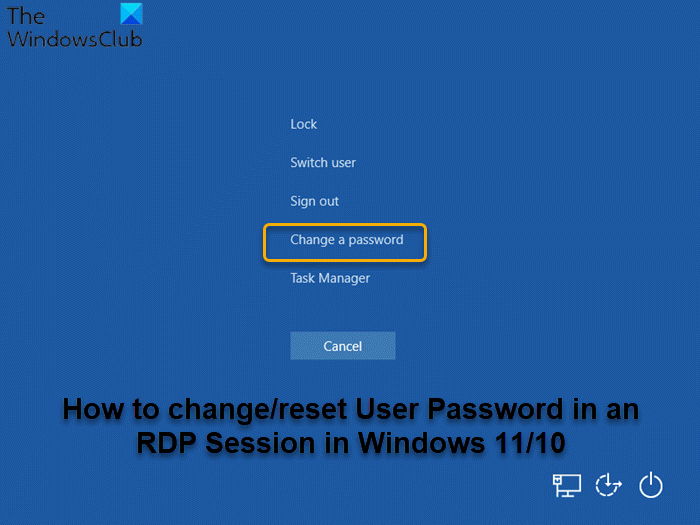What is the difference between RDP and VNC?
The main difference between RDP and VNC is, RDP is a virtual session, while VNC (Virtual Network Computing) captures the physical display – meaning you see exactly what the remote user sees. Nevertheless, both protocols provide access to remote desktops for quick and easy remote working and troubleshooting. RDP has limited platform capabilities. VNC connects directly to the computer; RDP connects to a shared server. RDP is typically faster than VNC.
How do I change my RDP username and password?
To change your RDP username and password, simply follow these instructions: log into your Windows Server via Remote Desktop. Open the Start menu and search for Computer Management and launch the utility. In the Computer Management console, navigate to Local Users and Groups > Users, then right click the desired Remote Desktop user (the default user is ServerAdmin) and select Set Password.
Change User Password in an RDP Session in Windows 11/10
You can change User Password in an RDP Session in Windows in the following ways:
1] CTRL+ALT+END Keyboard Shortcut
In some cases, the CTRL+ALT+END keyboard shortcut helps you CTRL+ALT+DEL the session to change your password in the remote session. CTRL+ALT+END is the equivalent to CTRL+ALT+DEL in RDP, as CTRL+ALT+DEL key combo doesn’t work in an RDP session – however, for it to work, depends on the running Windows version session settings.
2] ALTGR+END Keyboard Shortcut
German keyboards in particular have this key. In case you have a keyboard with the Alt Gr key, you can press the ALT GR+END key combo to simulate CTRL+ALT+DEL to access the Windows Security Options screen.
3] On-Screen Keyboard (OSK)
The On-Screen Keyboard (OSK) in Windows 11/10 is a virtual keyboard on your screen, which can also allow you to change your password. Here’s how:
Press Windows key + R to invoke the Run dialog.In the Run dialog box, type osk and hit Enter to launch the On-Screen Keyboard.Next, press and hold CTRL+ALT key combo on your physical keyboardNow, click on the DEL key in the OSK.Minimize the virtual keyboard.Click Change a password.
4] Run the Shell
With this method, you can directly run the Shell command to display the Windows Security Options. To run the Shell, do the following:
Invoke the Run dialog box or open a command prompt.In the Run dialog or CMD prompt, copy and paste in syntax below and hit Enter:
Click the Change a password on the Windows Security Options screen.
5] Create and run a Batch file
This method simply entails you create a batch file, and then run the .bat file to launch the Windows Security Options screen to change the password. Here’s how:
Press Windows key + R to invoke the Run dialog.In the Run dialog box, type notepad and hit Enter to open Notepad.Copy and paste the syntax below into the text editor.
Save the file with a name and append the .bat file extension – eg; WinSecOptions.bat and on the Save as type box select All Files.Now, you can run the batch file with admin privilege (right-click the saved file and select Run as Administrator from the context menu).
Reset User Password in an RDP Session in Windows 11/10
Unlike changing a password, to reset a user password, you do not need to remember the current password, rather you simply overwrite the existing password (if any) and then set a new password. You can reset User Password in an RDP Session in Windows in the following ways:
1] Active Directory Users and Computers
To reset a password via Active Directory Users and Computers on Windows, do the following:
Invoke the Run dialog.In the Run dialog box, type dsa.msc and hit Enter to open Active Directory Users and Computers console.Locate the user account you want to reset password for.Right-click the account, and choose Reset Password.
2] Run the Net User command
The net user command can be used to reset/change a users’ password on a Windows 11/10 computer, provided it’s a local user account and not a domain user account. Do the following:
Open Command Prompt.In the CMD prompt, type in the command below and hit Enter:
Substitute both the
3] Run PowerShell cmdlet
With this method you can change/reset a user password using PowerShell for both a local user and domain user accounts. For a domain user account, the Active Directory module must be loaded and you may use the PowerShell Set-ADAccountPassword cmdlet to reset a user password. Do the following:
Press Windows key + X to open Power User Menu.Tap i on the keyboard to launch PowerShell.In the PowerShell console, type in the command below and hit Enter.
Substitute both the UserName and InputNewPassword placeholder with the actual name of the user and the password you want. For a local user account, you may use the PowerShell Set-LocalUser cmdlet to reset a local users’ password. That’s it on how to change/reset User Password in an RDP Session in Windows 11/10!
How do I change the default RDP port?
PC users can change the default RDP port on a remote Windows 11/10 computer by following these instructions: invoke the Run dialog box, and then type in regedit and hit Enter to open Registry Editor. In regedit, navigate or jump to the following registry subkey: At the location, on the Edit menu, click Modify, and then click Decimal. Now, type the new port number, and then click OK. Exit Registry Editor and restart the computer.
How can I tell if RDP port is open?
To know if an RDP port is open on a Windows system, you need to open a command prompt and run the telnet command – one of the Command Line Parameters for Remote Desktop Connections in Windows 11/10. For example, type telnet 192.168. 8.1 3389 into the CMD prompt, and if a blank screen appears then the port is open, and the test is successful. Related post: Remove History entries from Remote Desktop Connection in Windows.

